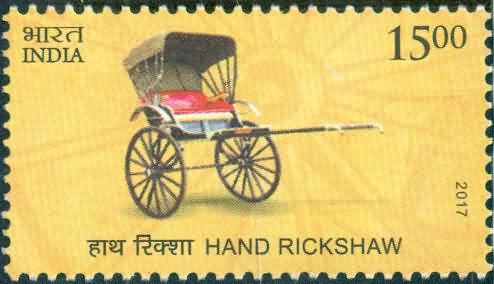Hand Rickshaw

Technical Data
| Stamp Set | Means of Transport |
|---|---|
| Date of Issue | March 25, 2017 |
| Denomination | Rs. 15 |
| Quantity | 3,000 |
| Perforation | 13 |
| Printer | India Security Press, Nashik |
| Printing Process | Wet Offset |
| Watermark | No Watermark |
| Colors | Multicolor |
| Credit (Designed By) | Sh. Brahm Prakash |
| Catalog Codes |
Michel IN 3137 Yvert et Tellier IN 2828 Stanley Gibbons IN 3291 |
| Themes | Transport |
Introduction
The Hand Rickshaw, also known as the Pulled Rickshaw, represents an early phase in India’s urban transport evolution. Emerging in the late 19th century, it played a vital role in the mobility of people in narrow city lanes before the rise of motorised transport.
Origin and Early Use in India
Hand rickshaws appeared in India around 1880, first introduced in Shimla, and about two decades later became common in Kolkata. Initially, they were used by Chinese traders to transport goods. Soon after, they became a means of passenger transport as urban populations grew.
Design and Structure
A Hand Rickshaw is a two-wheeled passenger cart, manually pulled by a single person:
- Equipped with a seat for 1–2 passengers
- Lightweight wooden or metal structure
- Pulled by a man harnessed in front
It was especially suited for congested and uneven streets where horse-drawn carriages could not easily operate.
Socio-Economic Context
Pulling a rickshaw became one of the first occupations for migrant peasants arriving in big cities. It provided a source of livelihood to thousands, particularly in Kolkata, where the hand-pulled rickshaw became an iconic part of the city’s culture and daily life.
Legacy and Evolution
Over time, hand-pulled rickshaws paved the way for:
- Cycle rickshaws
- Auto rickshaws
- School rickshaws
Today, although largely phased out or regulated due to labour concerns, hand rickshaws remain a historical symbol representing the early evolution of public transport in India.
Conclusion
The Hand Rickshaw stands as an important milestone in India’s transport history—marking the transition from traditional manual mobility to more modern, mechanised modes of transport. It reflects both the challenges and the resourcefulness of urban life in India’s past.
